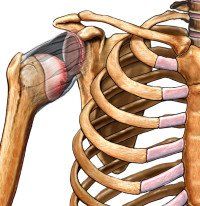Shoulder Impingement Syndrome
Impingement Syndrome, one of the most commonly treated shoulder injuries, is a condition that involves one of the main rotator cuff muscles that makes up the shoulder. The Supraspinatus muscle lies on the top of the shoulder and is responsible for producing elevation of the arm (reaching overhead). Originating off the scapula (shoulder blade), the Supraspinatus runs along the top of the shoulder, and its tendon attaches to the ball of the humerus. As the tendon courses its way to the humerus, it passes beneath the acromion (front edge) of the shoulder blade, which can sometimes be hooked, rough, and sharp. With very little space in this region, it is essential that the tendon move freely.
Impingement occurs in this area when the Supraspinatus muscle and tendon becomes routinely pinched in of this small space. Impingement mainly occurs when the individual performs overhead activities, therefore forcing the tendon into the acromion. The result can be a sharp and shooting pain in the front and top of the shoulder that may or may not radiate down the arm. It is important to note that chronic impingement syndrome can lead to rotator cuff tears.
Treatment for impingement syndrome is crucial in avoiding further shoulder injury. Your physician may prescribe therapy to assist in regaining range of motion, decreasing pain, and increasing strength. You will also be educated on proper shoulder and scapular exercises to improve posture and core strength. The main goals in treating impingement syndrome are decreasing tendon inflammation, improving posture, and avoiding further injury.
In more severe cases when conservative treatments fail, your physician may recommend surgery (subacromial decompression) to alleviate the strain placed on the tendon by the overlying bony acromion. Therapy will typically be prescribed following the surgery to increase mobility & strength to the shoulder and maximize function.
MEDICAL DISCLAIMER: The information contained in this website is intended for informational and educational purposes only. You should always with your physician for the diagnosis and treatment of any injury or condition. The content on this web site is general in nature and not complete, and it should never be used for diagnostic or treatment purposes.
